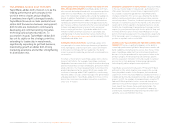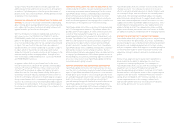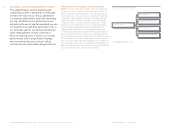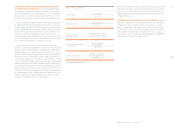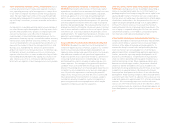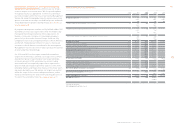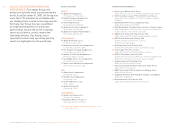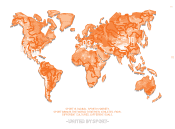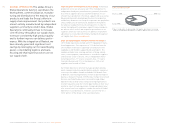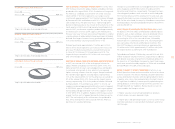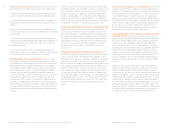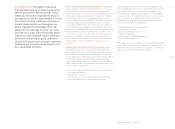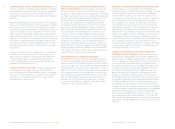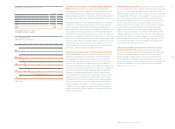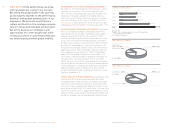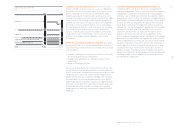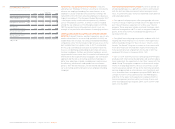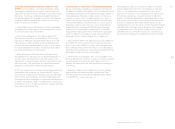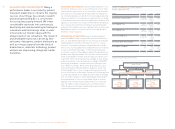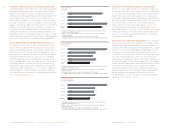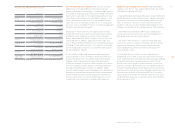Reebok 2007 Annual Report Download - page 68
Download and view the complete annual report
Please find page 68 of the 2007 Reebok annual report below. You can navigate through the pages in the report by either clicking on the pages listed below, or by using the keyword search tool below to find specific information within the annual report.064
ANNUAL REPORT 2007 --- adidas Group GROUP MANAGEMENT REPORT – OUR GROUP -- Corporate Functions - Global Operations - Sustainability
FOCUS ON FIVE INITIATIVES Global Operations is focusing on
fi ve key initiatives to optimize processes in our supply chain:
- Replenishment: Providing high availability of product to our
customers while minimizing our inventory of fi nished goods.
- End-to-End Profi tability: Identifying our key cost and profi t-
ability drivers and their interrelationships to optimize decision-
making.
- Adaptive Supply Network: Enhancing the fl exibility of both
our sourcing and logistics functions to address quick-changing
market needs.
- End-to-End Planning: Fundamentally challenging and opti-
mizing our Group-wide demand and supply planning processes
to create more effi cient, transparent and cross-functionally
interlinked processes.
- Accelerated Creation-to-Shelf: Building capabilities and
technology that drive faster and more effi cient product creation
to enhance the Group’s top- and bottom-line growth.
ADVANCEMENTS WITH ALL INITIATIVES In 2007, we made
fi rst steps in all fi ve areas. We started utilizing real-time sell-
through data on a Stock Keeping Unit (SKU) level to determine
replenishment needs at adidas own-retail stores in Europe.
This helped us identify additional sales potential and reduce
overall markdowns. As part of our End-to-End Profi tability
initiative, we developed a profi tability simulation model that
incorporates product creation and delivery costs (i. e. total cost
perspective) to support decision-making in sourcing and
transportation. With respect to the Adaptive Supply Network
initiative, we made signifi cant progress in warehousing and
launched several IT projects to improve speed and fl exibility in
our supply chain. During the year, we also started our End-to-
End Planning initiative with new demand and supply planning
concepts.
Within the scope of the Accelerated Creation-to-Shelf initiative,
we implemented 6- and 13-month concept-to-shelf pro cesses
(i. e. all activities from the fi rst product sketch to the fi nal
delivery to retailers) to support newly introduced business
models at brand adidas. 30 % of the fall / winter 2008 product
range was placed on those quicker timelines. In addition, for
the fi rst time we used virtual product prototypes to accelerate
our product review process and reducing sampling costs.
SUCCESSFUL COMPLETION OF “WORLD CLASS BUYER” PRO-
GRAM In 2007, we were able to realize signifi cant benefi ts as
a result of our “World Class Buyer” program. The objective
of this program was to maximize purchasing leverage across
the adidas and Reebok brands. During the year, we fi nalized
the implementation of a standardized costing framework for
both brands in footwear and made signifi cant progress with
the roll-out of a similar framework in apparel. As a result,
we generated cost synergies at both brands. see Income
Statement, p. 080
FURTHER INTEGRATION BENEFITS IN LOGISTICS In 2007,
we achieved signifi cant synergies in freight and transportation
costs as a result of the harmonization of our global service
provider network. We also made major headway in warehouse
integration. In the UK, construction of our new central distri-
bution center for the adidas and Reebok brands in Manchester
was completed in December. Operations are planned to com-
mence in the fi rst half of 2008, so we expect to see the fi rst
cost savings materialize in 2008. Also, construction work for
our two new central US distribution centers in Spartanburg,
South Carolina, began in 2007. We expect to start operating our
US apparel distribution center in the fourth quarter of 2008
and our US footwear warehouse a year later. These two new
facilities will replace fi ve existing adidas and Reebok ware-
houses.
FIRST SUCCESS IN REEBOK APPAREL BUILD-UP In 2007, we
stepped up our efforts to establish an in-house apparel orga-
nization for the Reebok brand. On the sourcing side, we phased
out Reebok’s former sourcing agents. This means that we will
source Reebok apparel solely through our own supply base
utilizing the established network of the adidas brand. Reebok
also developed its fi rst full apparel collection (spring / summer
2008) in the new organizational set-up following adidas best
practice processes. In the coming years, we will focus on
further improving Reebok’s apparel processes to achieve
performance levels in line with the adidas brand.
PROGRESSIVE RAMP-UP OF “WORLD CLASS SUPPLY CHAIN”
AT BRAND ADIDAS In 2005, we started our “World Class
Supply Chain” initiative to optimize adidas’ product offering, to
best attack market opportunities and to improve profi tability.
In 2007, we further extended its global footprint by imple-
menting the brand model to all markets globally. The brand
model delivers adidas brand concepts (e. g. adiSTAR, TECHFIT™,
Predator®) to all markets globally with fi rst priority in our
supply chain, communications support and retail execution.
The evergreen model provides short lead time and never-out-
of-stock capabilities for our most com mercial long-lifecycle
products (e. g. basic apparel lines) through continuous replen-
ishment.
In 2007, we also launched the quick response and global /
regional models. The quick response model allows us to seize
additional market opportunities with six-month concept-to-
shelf processes. We also put in place a customization business
model for “mi adidas”, which is being extended to customized
football team wear. Under our global / regional model, we have
established four product creation centers around the globe to
ensure that we have the right mix between global consistency
and regional specifi cs to best address consumer needs in the
respective markets. Together, these four business models give
the adidas brand a competitive advantage to service a diverse
set of market needs in a more relevant and specifi c way.


